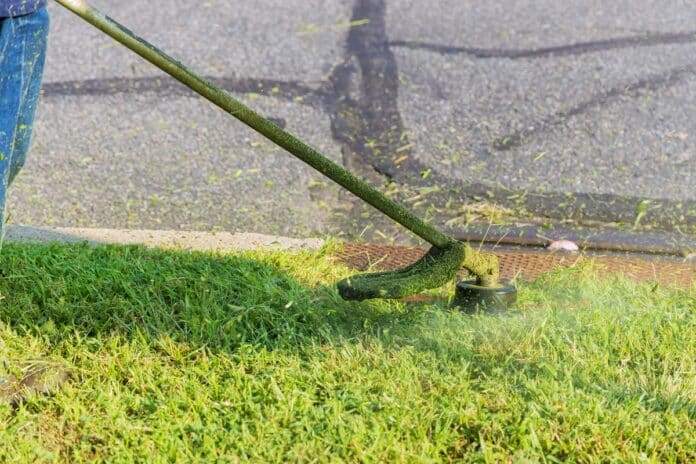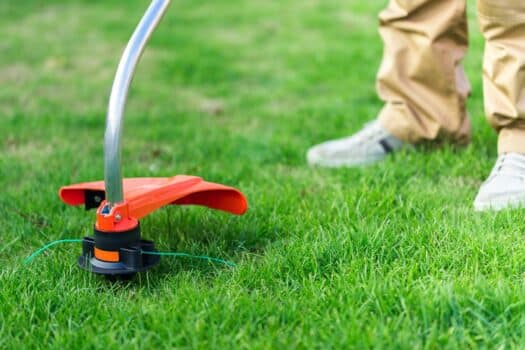How To Use A Weed Eater? | All You Need To Know

Disclaimer | This article may contain affiliate links, this means that at no cost to you, we may receive a small commission for qualifying purchases.
Using weed eaters is arguably the best way to trim overgrown grass to avoid hours of labor-intensive work. There are different weed eater models, from gas-powered to electric trimmers. However, using a weed whacker without considering the safety precautions can cause serious accidents.
If you’re enthusiastic about lawn maintenance, you probably have the best 4 cycle weed eater to trim grass and weed, especially during summer and spring.
However, purchasing the best weed whackers won’t do you any good if you don’t know how to use the tool properly without raising safety issues. So, in today’s article, we’ll discuss the correct steps and some safety tips you can follow to use a weed eater.
What Are The Right Steps To Use Weed Eaters?
Step 1
Firstly, you need to know how to string a weed eater to use it correctly. Pull out around 6 inches of the starter cord to get the weed whacker running. In most cases, this is the optimal wire length you’ll need to start the machine.
You have to crank the string in a gas trimmer, while you can simply push the “on” button in an electric trimmer. Moreover, you must refer to the user manual on how to prime a gas-powered model to start it. Also, make sure to press down the throttle to keep the weed whacker running.
Step 2
Hold the trigger with one hand and the weed eater handle with the other. It’s the safest way of using a weed whacker and minimizes the chances of injuries. Always remember to keep the throttle or trigger at your waist level.
If you feel any strain in your back or wrists from using the weed eater, turn it off and rest for a while before continuing to cut grass in the garden or driveway. You can also use a shoulder strap to clip the weed whacker to its bottom and take some weight off your arms.
Step 3
Next, lower the weed eater’s cutting head to the ground and simply press on the weeds while maintaining a distance of about an inch. Don’t lower the weed whacker all the way to the ground because it’ll slice dirt and ruin the cord.
Also, keep the weed whacker as steady and level as possible while lowering it for an even trimming. However, if you need to level out the weeds even further after trimming the yard, you can use a lawn mower to complete the job.
Step 4
Carefully determine the direction in which the wire spins and move the weed eater for about a foot to create a clean-cut path. For instance, if the wire is spinning clockwise, move your trimmer from the left to the right side. Always move the weed eater from side to side while slowly walking forward.
If you notice that the weed eater isn’t cutting the weeds instantly, you can turn it off and pull out more wire. Some models automatically roll out wires if you press a button, while you must manually pull the wire for others.
Step 5
Always use the tip of the weed eater’s nylon wire to cut weeds because it generates the strongest force at the tip. Avoid cutting large swaths with the entire wire due to the chances of overloading the engine. You need to be extra careful to prevent an engine overload while cutting thick, tall, and densely-packed grasses, which can be pretty tricky to trim down.
Step 6
Lastly, tilt the weed eater at a right angle while edging along a fence or hard surface to cut weeds. Turn the weed whacker at 90 degrees while holding it firmly without dropping it.
Furthermore, moving the spinning wire creates a gap between the plants and the surface edges. Using your weed trimmer, you can also cut into the ground to create a much more prominent gap to edge the area.
How To Safely Use A Weed Eater?
1. Put On Your Safety Gear
Weed whackers have a spinning wire, known as the trimmer line, for cutting or trimming grass or weed in your backyard. Since a weed eater is a power tool, it can cause severe injuries because of this spinning wire. It’s best to wear close-toed shoes to prevent your feet from coming in contact with the wire and avoid injuries.
Furthermore, a string trimmer is bound to produce flying debris while cutting grass on the lawn, so wearing work gloves and safety glasses can protect your hands and eyes. Gloves will also prevent your palms and fingers from bruising or becoming sore because of pushing around the weed eater for long hours.
Additionally, wear sturdy and long pants to protect your legs from injuries. Trimming weed can take long hours, so remember to wear a hat and stay hydrated, especially while working in the summer heat.
2. Avoid Using The Weed Trimmer On Hard Objects
Rocks or other hard objects are pretty common in backyards, but they can easily damage the cutting wire of your weed whacker. Thus, remove all small or medium-sized rocks and objects from the cutting area before trimming the grass.
If the object is too big to remove, carefully and slowly maneuver the trimmer around it to prevent the nylon wire from hitting the hard surface. The weed eater can also toss around small rocks, so avoiding such objects is best to ensure your safety.
3. Be Careful Of The Power Cable
If you’re using an electric trimmer, be careful with the power cable and avoid cutting or damaging it while trimming the lawn. It can cause a short circuit and damage your tool while also putting you in danger. Always keep the electrical cord behind you while using the weed eater to avoid the risks of accidentally damaging it.
Moreover, ensure that the cord stretches up to your work area from the power supply, or use an extension cord if the cable is short to prevent accidents. You won’t need to worry about such safety issues if you have a gas or battery-operated weed eater.
4. Check The Kill Switch On Your Weed Wacker
Most modern weed eater models come with a trigger or a throttle that you must constantly press while using the weed eater. Once you release the throttle, the weed eater will turn off automatically.
Go through your owner’s manual to locate this automatic kill switch or to determine whether your machine has one. If your weed eater doesn’t have this throttle or an automatic kill switch, learn about the on/off mechanism of the tool before you start using it.
5. Be Careful Of Harmful Fumes From Gas-Powered Weed Eaters
Gas-powered weed whackers produce toxic fumes, so if you own a gas-powered tool, avoid inhaling the fumes, especially when they are highly concentrated. Depending on how much gas does a weed eater use per hour, the concentration of these fumes will vary. So, always use these trimmer models in an open area having sufficient ventilation. You can also wear protective masks to avoid inhaling the fumes.
6. Let The Engine Cool Down
Once you’ve completed the job, lay the machine on a non-flammable surface for five to ten minutes. It will allow the engine to cool down completely before you can put away the weed eater in your storage room. It’s best to put the weed eater under a shade to cool off instead of keeping it under direct sunlight.
You can safely store the weed eater by putting it on a shelf, laying it on the floor, or hanging it in a vertical position on your garage wall. Whatever you do, keep the tool away from moisture and open flames. If you own a gas weed eater and plan to store it for more than a month, drain the fuel tank carefully.
How To Avoid Common Mistakes While Using A Weed Eater?
1. Double-Check Your Protective Gear
The most common mistake people make while using a weed eater is wearing the wrong protective gear. For instance, avoid wearing loose or baggy clothes while operating a wood whacker because they might get stuck in the wire and cause injuries. Also, double-check the quality of your work pants, shoes, gloves, and safety glasses.
2. Determine The Trimmer’s Spin Direction
People often get confused while determining the spin direction of the string and end up moving the trimmer in the wrong direction. If the wire spins anti-clockwise, the trimmer will eject the debris on the left side while cutting the weeds on the right. So, under such circumstances, always move the trimmer from right to left to avoid ejecting debris on the freshly cut path or bogging down the weed eater.
3. Keep The Trimmer At A Safe Distance From The Ground
People often think that pressing the weed eater close to the ground will offer faster and better results, but in reality, it does more harm than good.
If you lower the weed whacker too close to the ground, it’ll start to slice up the lawn soil and tear down the nylon wire. So, always keep the trimmer at a safe distance from the soil to avoid damaging your lawn or the trimmer itself.
How To Use A Weed Eater Final Words
If you want your lawn and yard to look beautiful, regularly trimming and cutting weeds is inevitable. And once you get the hang of using a weed eater, it becomes quite easy as long as you follow the safety precautions.
Battery-powered models can be a good option if you’re a first-time user because you don’t have to worry about cutting the power cord or inhaling harmful fumes. However, you can go for electric models with more experience because they are better at producing faster results while lowering your carbon footprint.
Whichever weed eater model you choose, make sure to put on your protective gear because prevention is always better than cure!
Checkout our next article on is it wise to use motor oil in a weed eater? for more information on the particular topic.



